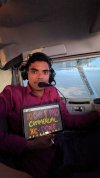Lihue to Hilo is 276 nm. But I think it's good not to require people flying beat-up trainers to fly the 70-mile open water leg between Oahu and Kauai.
But the problem is the phrase "longest segment" in the Hawaii part of the rule. I don't know how the Honolulu FSDO treats it. But it creates ambiguity in the requirement when you read it as a whole, which is the default rule for interpreting legal documents.
This requirement has 5 sub-requirements:
1. Cross-country flight
2. Not less than 300 nm total distance
3. Landings at a minimum of three points
4. One point of landing must be a straight-line distance of at least 250 nm from the original departure point
5. If meeting this requirement in Hawaii, the longest segment need only have a straight-line distance of at least 150 nm
There are at least four ways to read the requirements together:
(i) In Hawaii, you have to meet #4
and fly at least one 150 nm segment. That can't be right because it does not make sense for pilots in Hawaii to have to meet a requirement that mainlanders do not. While the airports in Hawaii are clustered together closer than most of us use for cross-country training requirements, they are not more so than you can find in, say, Florida.
(ii) In Hawaii, you do not have to meet #4 and must instead fly one 150 nm segment. That can't be right because that is not how the requirement is worded and because it requires pilots in Hawaii to meet a drastically different requirement than mainlanders, that being flying a 150-mile segment instead of having the option to fly five 50-mile segments or similar.
(iii) In Hawaii, requirement #4 is simply reduced to 150 nm instead of 250 nm. But that can't be right because it requires us to ignore the word "segment" in the regulation.
(iv) On the mainland, the 250-mile requirement is actually a single segment. That can't be right because it is not how the requirement is worded and it's not how anyone who matters (CFI, DPE, FSDO) seems to understand it.
@midlifeflyer is right. They need to fix the wording of the Hawaii exception, and apologize to everyone who flew all the way from Honolulu to Hilo without stopping at Hana or Kona.


